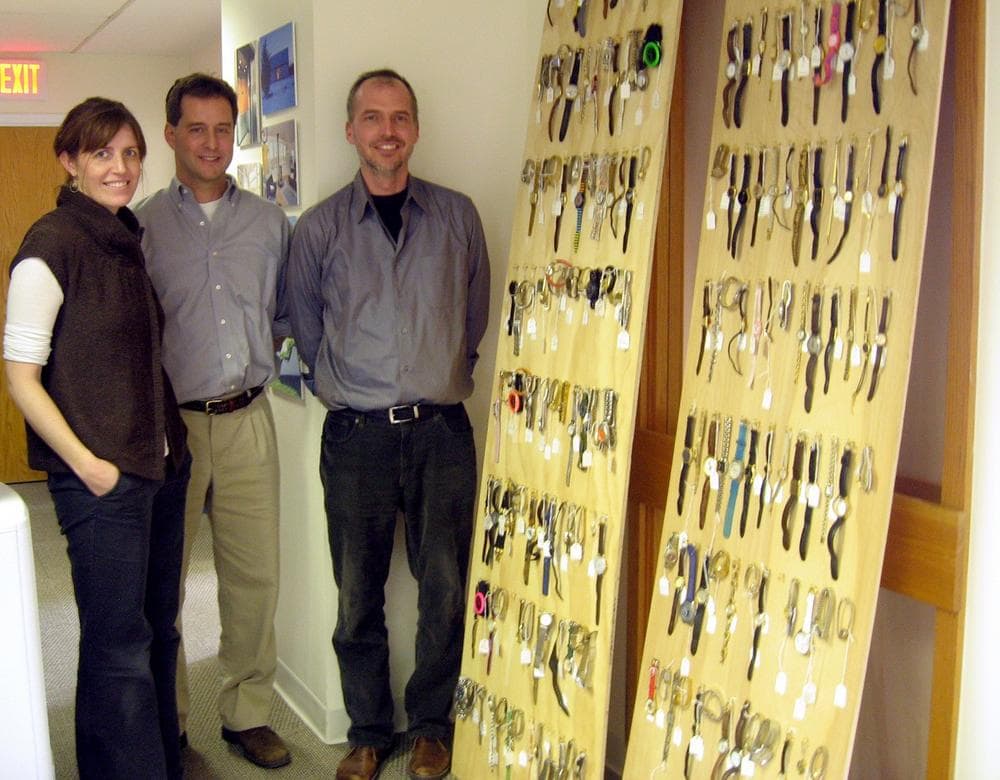Advertisement
1,000 Watches Capture Moment In Time
ResumeWhere do you find the time? On your cellphone? Or PDA? What about a wristwatch? Well, some Boston architects fear the wristwatch is going the way of the pocket watch as people rely more on high-tech devices to tell time. To mark this shift — and to give dear, old time pieces a dignified place to retire — they created the Thousand Watch Project.
[soundslide]http://www.wbur.org/files/soundslides/2009/wbur_0513_1000-watches[/soundslide]Think, for a second, about the watches in your life.
Are you remembering your grandmother's Cartier? A friend's Mickey Mouse watch? That reliable Timex you received at graduation?
For architect Keith Moskow, a plastic brand-name watch he bought in Switzerland in the 80s comes to mind. It was a clear Swatch, he says — "you could see all the workings. " Moscow wore it so long that it turned yellow and he never could throw it out.
A few years ago, Moskow's colleagues at his Boston firm, Moskow Linn, fessed up to hoarding their old watches, too. In sock drawers and dusty jewel cases. So they put out a communal box to collect their forgotten time pieces. Then they decided to put name tags on them, or epitaph tags, because Moskow says, "in a sense it's rest-in-peace."
Quite literally, in fact, for Moskow's design partner Robert Linn. About the time they started collecting, he says his dad died, "so the watch that he wore for all the years we lived together was watch No. 1."
The epitaph tag on the old Sieko reads, "Watch from John Linn, kept in drawer by side of bed." Linn's dad took it off every night and put it back on every morning. That simple daily routine demonstrates an intimate connection between people and wristwatches.
They touch our skin. They're most always with us. They symbolize moments in our lives. And people.

The watch collection grew as clients and vendors added to the stash. Figuring they were on to something, the architects set a goal: collecting 1,000 watches. They solicited donations to their Thousand Watch Project through Craigslist and other sites. Soon packages arrived, with letters — sometimes even eulogies. Five hundred so far. And they're still coming.
Keith Moskow says some of the watch epitaphs are less than nostalgic. One reads: "Swiss Army reliability my ass." It's signed Major Lance Windell.
Like Major Windell's watch, the hundreds of tagged Casios, Swatches and fake Rolexes don't work either. There's a Superman watch sent by a second-grade school teacher in Wisconsin. And a chunky diver's watch that traveled here from Australia. Forty-nine-year-old Shane Hughes sent it from New Castle, Australia. Here's what he wrote in his letter:
"I bought this watch when I was a young back packer in Europe, so we’ve been through most of life’s experiences together. I couldn’t bear the thought of my watch ending up on a rubbish tip somewhere and I thought your project would bring its usefulness as timepiece to a dignified end. So the epitaph will simply read, 'RIP, you’ll always remind me of my youth.'"
But today's youth might miss out on this relationship.
"My kids who are teenagers do not wear wristwatches," said Thousand Watch Project founder Keith Moskow. "Our employees in the office who are in their 20s do not wear wristwatches. So in a sense, it also marks a period of time where we're going from wearing wristwatches to not wearing them at all."
One 20-something disagrees. 26-year-old Ben Clymer insists he and his peers do wear watches. He's the executive editor of Hodinkee, a blog about wristwatches all over the world, and says he owns two old watches, "One of which was owned by my grandfather on my mother's side — he gave to me for my sixteenth birthday — and I also own a watch from my grandfather on my father's side that was actually given to him on his thirtieth anniversary at Bell Labs."
Clymer says he supports the Boston-based watch project. When the collection reaches 1,000, it will be packed in a pine box resembling a tiny coffin and sent to the Smithsonian Institution in Washington, D.C.
Each watch is also part of a Web site photo gallery, where donors, and anyone else, can visit and pay their respects.
This program aired on May 13, 2009.
